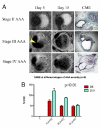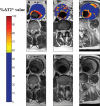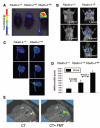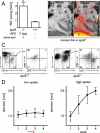Molecular imaging of aortic aneurysms
- PMID: 22592009
- PMCID: PMC3386267
- DOI: 10.1161/CIRCIMAGING.112.973727
Molecular imaging of aortic aneurysms
Figures




Similar articles
-
Emergence of molecular imaging of aortic aneurysm: implications for risk stratification and management.J Nucl Cardiol. 2014 Apr;21(2):251-67; quiz 268-70. doi: 10.1007/s12350-013-9845-5. Epub 2014 Jan 1. J Nucl Cardiol. 2014. PMID: 24381115 Free PMC article. Review.
-
Functional and molecular imaging techniques in aortic aneurysm disease.Curr Opin Cardiol. 2013 Nov;28(6):609-18. doi: 10.1097/HCO.0b013e3283644beb. Curr Opin Cardiol. 2013. PMID: 24030165 Review.
-
Multi-modality molecular imaging of aortic aneurysms.J Nucl Cardiol. 2017 Aug;24(4):1239-1245. doi: 10.1007/s12350-017-0883-2. Epub 2017 Apr 26. J Nucl Cardiol. 2017. PMID: 28447279 Free PMC article. Review.
-
Inflammatory aortic aneurysms: characteristic appearance on magnetic resonance imaging.Eur J Vasc Surg. 1992 Jul;6(4):399-402. doi: 10.1016/s0950-821x(05)80287-7. Eur J Vasc Surg. 1992. PMID: 1499743
-
Magnetic resonance imaging of thoracic aortic aneurysms: comparison with other imaging methods.AJR Am J Roentgenol. 1986 Feb;146(2):309-14. doi: 10.2214/ajr.146.2.309. AJR Am J Roentgenol. 1986. PMID: 3510513
Cited by
-
Morphological and Biomechanical Differences in the Elastase and AngII apoE(-/-) Rodent Models of Abdominal Aortic Aneurysms.Biomed Res Int. 2015;2015:413189. doi: 10.1155/2015/413189. Epub 2015 May 3. Biomed Res Int. 2015. PMID: 26064906 Free PMC article.
-
Molecular imaging of atherosclerosis: clinical state-of-the-art.Heart. 2014 Sep 15;100(18):1469-77. doi: 10.1136/heartjnl-2011-301370. Epub 2013 Dec 23. Heart. 2014. PMID: 24365664 Free PMC article.
-
Multimodal iron oxide nanoparticles for hybrid biomedical imaging.NMR Biomed. 2013 Jul;26(7):756-65. doi: 10.1002/nbm.2872. Epub 2012 Oct 15. NMR Biomed. 2013. PMID: 23065771 Free PMC article. Review.
-
Ascending thoracic aortic aneurysms protect against myocardial infarctions.Int J Angiol. 2014 Sep;23(3):177-82. doi: 10.1055/s-0034-1382288. Int J Angiol. 2014. PMID: 25317029 Free PMC article.
-
Imaging macrophages with nanoparticles.Nat Mater. 2014 Feb;13(2):125-38. doi: 10.1038/nmat3780. Nat Mater. 2014. PMID: 24452356 Review.
References
-
- Johnston KW, Rutherford RB, Tilson MD, Shah DM, Hollier L, Stanley JC. Suggested standards for reporting on arterial aneurysms. Subcommittee on reporting standards for arterial aneurysms, ad hoc committee on reporting standards, Society for Vascular Surgery and North American Chapter, International Society for Cardiovascular Surgery. J Vasc Surg. 1991;13:452–458. - PubMed
-
- Guo DC, Papke CL, He R, Milewicz DM. Pathogenesis of thoracic and abdominal aortic aneurysms. Ann N Y Acad Sci. 2006;1085:339–352. - PubMed
-
- Absi TS, Sundt TM, 3rd, Tung WS, Moon M, Lee JK, Damiano RR, Jr., Thompson RW. Altered patterns of gene expression distinguishing ascending aortic aneurysms from abdominal aortic aneurysms: Complementary DNA expression profiling in the molecular characterization of aortic disease. J Thorac Cardiovasc Surg. 2003;126:344–357. - PubMed
-
- Hirsch AT, Haskal ZJ, Hertzer NR, Bakal CW, Creager MA, Halperin JL, Hiratzka LF, Murphy WR, Olin JW, Puschett JB, Rosenfield KA, Sacks D, Stanley JC, Taylor LM, Jr., White CJ, White J, White RA, Antman EM, Smith SC, Jr., Adams CD, Anderson JL, Faxon DP, Fuster V, Gibbons RJ, Hunt SA, Jacobs AK, Nishimura R, Ornato JP, Page RL, Riegel B. ACC/AHA 2005 practice guidelines for the management of patients with peripheral arterial disease (lower extremity, renal, mesenteric, and abdominal aortic) Circulation. 2006;113:e463–654. - PubMed
Publication types
MeSH terms
Grants and funding
LinkOut - more resources
Full Text Sources
Medical

